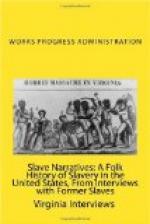“Miss Cloe, Miss Cornelia, and Miss Sarah cook up a whole lot of good things to eat and go to camp meeting. Sometimes they would stay a week and longer. They would take time bout letting the colored folks go long. We had big times. My grandpa took a gingercake cutter with him and sold gingercakes when they come out of the church. He could keep that money his own. I don’t know how he sold them. My sister has the cutter now I expect. My girl has seen it. It was a foot long, this wide (5 inches), and fluted all around the edges, and had a handle like a biscuit cutter. They was about an inch thick. He made good ones and he sold all he could ever make. Grandpa took carpet sacks to carry his gingercakes in to sell them. I remember that mighty well. (The shape of the cutter was like this: [Illustration].) He purt nigh always got to go to all the camp meetings. Folks got happy and shouted in them days. It would be when somebody got religion. At some big meetings they didn’t shout.
“When I was born they had a white mid-wife, Miss Martin. My mistress was in the cabin when I was born. I was born foot foremost and had a veil on my face and down on my body a piece. They call it a ‘caul.’ Sometimes I see forms and they vanish. I can see some out of one eye now. But I’ve always seen things when my sight was good. It is like when you are dreaming at night but I see them at times that plain in day.
“I don’t know how old I am but I was a good size girl when ’mancipation come on. Miss Cornelia had my age in her Bible. They done took me from the cabin and I was staying at the house. I slept on a trundle bed under Miss Cornelia’s bed. Her bed was a teaster—way high up, had a big stool to step on to go up in there and she had it curtained off. I had a good cotton bed and I slept good up under there. Her bed was corded with sea grass rope. It didn’t have no slats like beds do now.
“Colored folks slept on cotton beds and white folks—some of em at least—picked geese and made feather beds and down pillows. They carded and washed sheep’s wool and put in their quilts. Some of them, they’d be light and warm. Colored folks’ bed had one leg. Then it was holes hewed in the wall on the other three sides and wooden slats across it. Now that wasn’t no bad bed. Some of them was big enough for three to sleep on good. When the children was small four could sleep easy cross ways, and they slept that way.
“They had shelves and tables and chairs. They made chests and put things in there and set on top of it too. White folks had fine chests to keep their bed clothes in. Some of them was made of oak, and pine, and cypress. They would cook walnut hulls and bark and paint them dark with the tea.
“I recollect a right smart of the Civil War. We was close nough to hear the roar and ramble and the big cannons shake the things in the house. I don’t know where they was fighting—a long ways off I guess.




